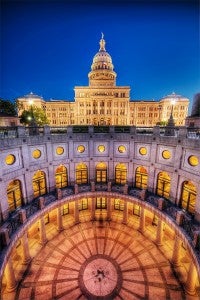Shut Down The Texas Government (Power)!

These days it seems “shutting down” the government is a popular rallying cry in Texas. So, why not do it…er…or at least shut down the electricity when it’s not being used!?
As many of us enjoy the shortened work week due to the Labor Day holiday on Monday, I thought it would be a good time to look into what kind of demand response (DR) government buildings can participate in during holiday and seasonal closings.
We have discussed the benefits of both residential and commercial DR and governments can represent large or small entities depending on their size. The Texas Facilities Commission (TFC), responsible for “planning, providing and managing facilities for more than one hundred state agencies in over 290 cities throughout Texas,” has a current inventory totaling “24 million square feet of leased and state-owned properties.” Of that, offices make up about 6 million square feet across eight different cities.
These state agencies annually “consume over $200 million in electricity, which is procured and billed on thousands of separate accounts through various providers. In an effort to reduce these expenditures, the Office of Energy Management (OEM) is looking at ways to aggregate the State’s electrical load into fewer accounts, perhaps into just one. This strategic initiative could take advantage of negotiation opportunities, economies of scale, consolidation of facility loads and load scheduling resulting in the TFC saving thousands of dollars a year on electricity alone.”
Furthermore, the “OEM is taking a more expansive look at its resources, including purchasing, producing and distributing, and actual consumption. For example, it recently proposed aggregating the States electrical load to benefit from economies of scale, wholesale rates, reduced peak demand charges, and to acquire a more sophisticated rate structure and is currently studying the possibility of incorporating combined heat and power in its production.”
The TFC is also working with the General Land Office (GLO) to aggregate smaller state agency accounts to provide volume discounts for these accounts. Currently, smaller state agencies procure gas supplies from the local gas companies or in amounts from the GLO that do not render the economies of scale capable with the aggregate consumption with the TFC. By aggregating these smaller amounts, the TFC gets a better deal for the buildings under the TFC’s control and the other agencies.
These agencies are already looking at ways to aggregate for convenience and ease of billing. Additionally, they are considering ways to vertically integrate where possible. For example, “TFC is studying a comprehensive energy management strategy for the state to generate its own electricity to serve the Texas Capitol Complex. Current annual electric expenses total $13 million to $14 million and, according to preliminary studies, the state could reduce costs by $4 million to $6 million by producing its own electricity.” This type of thinking is encouraging and could easily enable DR as well. These agencies already take advantage of energy rebates and efficiency upgrades where applicable, so it seems that DR would be appealing as an addition to their suite of energy management options, especially when considering that “utility costs for state facilities managed by TFC account for 39% of the agency’s general revenue budget.”
These steps combined with the progress made at the State Energy Conservation Office (SECO) can really help implement government DR if the will and proper planning was in place. SECO currently has multiple programs including the: Texas Cool Schools, LoanSTAR Revolving Loan Program, the Schools/Local Government Energy Program, the Energy Education Curriculum Program, Energy Management Services and the Innovative Energy Program, among other resources.
Luckily, SECO already encourages other demand side resources at schools around the state with their Solar for Schools program. This combines not only a way for school to reduce their electricity spending but provides a learning experience as well. “Since 2001, SECO’s Texas Solar for Schools Program has supplied many small-scale solar energy systems and complementary educational tools to school districts across the state. The schools save energy while saving money on their electric bills, and the students learn firsthand about renewable energy and energy conservation.”
“Each school receives a 1 kW system to 3 kW solar panel system, a web-based monitoring system, and several additional hands-on learning tools to enhance the educational component of the project as well as student and staff training. The grid-connected solar electric system supplements the electricity received from a utility company. During the installation, students are encouraged to participate as they are introduced to educational materials developed as part of the statewide campaign to educate Texans about renewable energy resources. The monitoring system allows teachers and students to compare their solar production with other schools.”
The gap however is in also leveraging demand response for government buildings and schools who seem to be prime candidates. There is no reason why state buildings should be running when no one is using them, and this extends to municipal facilities as well.
According to a US Department of Energy report to Congress, “state regulatory authorities and electric utilities should investigate new strategies for segmenting medium and small business customers to identify relatively homogeneous sub-sectors that might make them better candidates for price-based demand response approaches.” This investigation should mean state regulatory agencies look at themselves as well.
What is missing in Texas is a concrete analysis of how much potential DR there is in the government sector and what it would take to get there. Perhaps in future Master Plan Reports commissioned by the TFC, they can analyze what benefits can come from DR just as they have looked into combined power and heat. This would save them money which ultimately saves the taxpayers money.
It just makes sense that while we’re enjoying our pool pumps, air conditioning and ceiling fans on a hot summer holiday, that the unoccupied government building down the street is not wasting energy but instead shifting or creating it.










